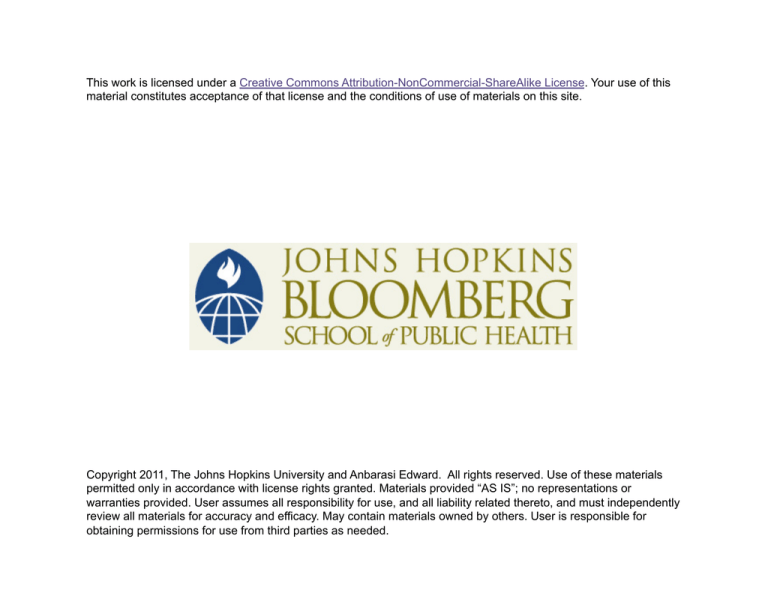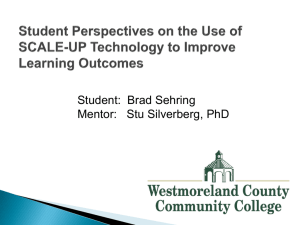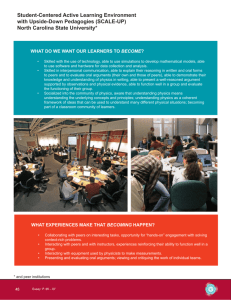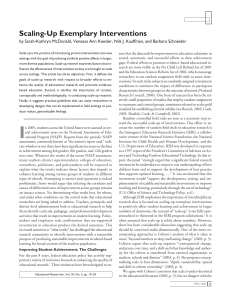
This work is licensed under a Creative Commons Attribution-NonCommercial-ShareAlike License. Your use of this
material constitutes acceptance of that license and the conditions of use of materials on this site.
Copyright 2011, The Johns Hopkins University and Anbarasi Edward. All rights reserved. Use of these materials
permitted only in accordance with license rights granted. Materials provided “AS IS”; no representations or
warranties provided. User assumes all responsibility for use, and all liability related thereto, and must independently
review all materials for accuracy and efficacy. May contain materials owned by others. User is responsible for
obtaining permissions for use from third parties as needed.
Section B
Examining Factors that Led to Chokwe Programs’ Stability
The views expressed in this presentation are Dr. Edward’s assessment of the model and are
not necessarily those of World Relief.
Volunteer Motivation and Retention
Elements Contributing to Volunteer Motivation and Retention
Clear job description and
expectations
Limited tasks
Span of operation: 10 neighbor
HH
Job aids to support
performance: health education
Empowerment: decision
making at community level
Peer support
Supportive supervision
Sense of accomplishment
Community recognition/status
Preferred treatment
Evidence of contributions:
improved health, referral
Availability of referral services
Opportunity for training and
skills development
Non-monetary incentives:
scarf, kapalana, t-shirt
Community identity
Guija and Mabalane districts: 20m post-project <10% attrition
Chokwe District: <2% drop out rate/y
3
Volunteer Support Systems
Regular supervision and joint
problem solving
Animators reside in communities
Supervisory checklists
Peer support “Care”
Culturally appropriate support
structure: VHC, Pastors
Community feedback and
recognition: graduation ceremony
Photos: Melanie Morrow, World Relief
4
Beneficial Outcomes of the CG System
Pivotal role between health system and community
Wide spectrum of services (preventive/curative)
Develop local capacity
Equitable and cost-effective delivery of services
Rebuilding social infrastructure—especially in post conflict settings
- Rwanda and Cambodia
5
SCALE Dimensions
Geographic: multiplicative strategies, modified approach of SEED/
SCALE
- WR expand scope to province level
- USAID mission CSP in three provinces
Organizational
- WR Cambodia (2), Malawi (2), Rwanda (2)
- FHI (scaling up in Sofala province), Curamericas, Africare, PLAN
Int, ADRA
Political
- Provincial and district MOH
- Leveraging interests of USAID mission, UNICEF, and other
multilateral agencies to adapt model for strengthening
community infrastructure and empowerment
UNICEF, ITN re-treatment
Functional
- Potential for integrating MED, PEPFAR, PMI, food security, child
development initiatives
6
Examining Factors Influencing Success of Scale-Up
Factors Influencing Scale
Present
Predictable adequate funding from international and local
sources for 20 years
?
Technological innovation within an effective delivery system
at a sustainable price: use of existing community structures,
effective simple interventions
Technical consensus on public health approach
Project and community governance (trade-offs between
quality and scale)
Effective use of information: evidence for advocacy,
integration with other sectors
7
Assessing Potential for Scale-Up
Steps for Scaling Up
Present
Establishing a vision for scale up
?
Determine effectiveness of approach
Assessment of potential for scale up
Consolidate, define and refine the approach
Build consensus for scale up
Advocating for supportive policies
8
Efforts for Supporting Scale Up
Support Systems for Scaling Up
Present
Determine roles and functions of stakeholders
Ensure funding and other resources
Develop/strengthen partner’s capacity to implement
activities
Design and institute M&E and supervision systems
Support institutional development for scale
?
9
The Case for Going to Scale
Donor driven, demand driven, top down, and bottom up
10
Strengthening Capacity of Health Systems
Strengthening capacity of health systems to support scaling-up
- Training district directors on supportive supervision, HFA, and
QA
- Improving competency of nurses in HC/HP through training in
technical interventions
- Designing and instituting CHIS and integrating into HIS
- Establishing community infrastructures (CG, VHC, socorrista),
financing mechanisms, referral systems
- Providing a prototype for sustaining community mobilization and
empowerment
- Advocating appointment for additional personnel (1/district) to
support socorrista and volunteer activities
11
Balancing Going to Scale with Equity
CG model achieves universal coverage of all community HH—reach
poorest
Socorristas provide health care to all patients, regardless of ability
to pay
Quality may be compromised if efforts for scale-up is the sole
responsibility of MOH
12
Scale Squared Center: Training and Learning
Best Practices for C-IMCI
13
Scale Squared Training Center
Photos: Melanie Morrow, World Relief
14
Scale-Up: Strengths
Compliments MOH efforts and addresses priorities for IMCI
Facilitates a coordinated approach within the districts in the
province
Supports the establishment of an effective management and health
information system—early warning system
Ensures compliance of case management protocols and guidelines
Strengthens linkages between the community and health systems—
and improved communication
Joint problem solving and resource sharing
15
Scale-Up: Strengths
Enables the establishment of effective strategies for sustainability
and phasing out
Allows top-down, bottom-up, and inside-out capacity building
Long-term vision and effective liaising of partners
CG model: equitable and sustainable approach mobilizing and
empowering communities
Prototype for multisectoral platform: PEPFAR, PMI, food security
Increased demand for services
16
Scale-Up: Weaknesses
Vision for “scale” not planned at outset
Creating and sustaining local enabling environment
Limited access to the provincial capital from the districts
Reduced capacity of health systems in some districts (rural HP/HC
lower staff competency/performance)
Increased geographic constraints (roads, scattered households,
public transport) requiring additional resources for transport,
communication equipment, safety of project personnel, etc.
Integrating and coordinating priorities of stakeholders (for example,
national HFA)
Advocating high-level leadership and political environment
17
Linking Community-Based Systems
18
Beware!
Carl Taylor
Community
Empowerment
19









